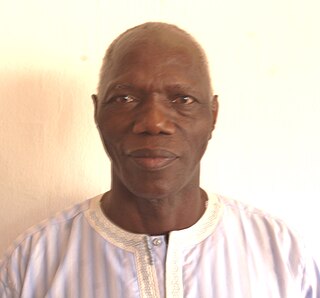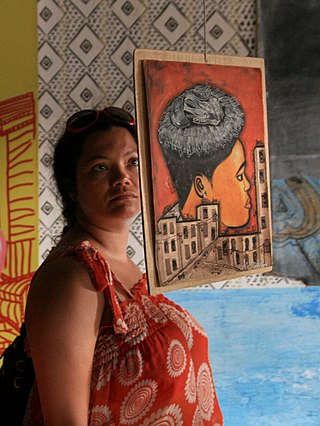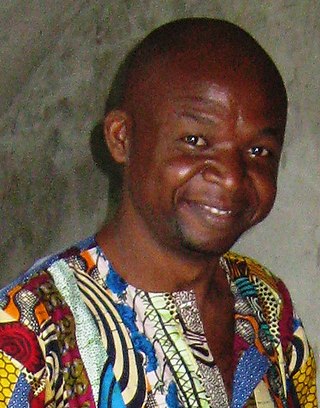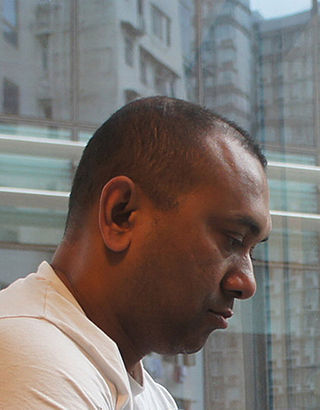
Biennale, Italian for "biennial" or "every other year", is any event that happens every two years. It is most commonly used within the art world to describe large-scale international contemporary art exhibitions. As such the term was popularised by Venice Biennale, which was first held in 1895. Since the 1990s, the terms "biennale" and "biennial" have been interchangeably used in a more generic way - to signify a large-scale international survey show of contemporary art that recurs at regular intervals but not necessarily biannual. The phrase has also been used for other artistic events, such as the "Biennale de Paris", "Kochi-Muziris Biennale", Berlinale and Viennale.
Georges Adéagbo is a Beninese sculptor known for his work with found objects.
Calixte Dakpogan is a Beninese sculptor known for his installations as well as his masks made out of diverse and original found materials. A native of Pahou, he currently lives and works in Porto Novo. Much of his work is inspired by his Voudon heritage.
Berry Bickle is a Zimbabwean artist who resides in Maputo. Born in Bulawayo, Bickle attended the Chisipite Senior School in Harare. Later, she attended the Durban Institute of Technology, where she obtained a national diploma in fine arts, and South Africa's Rhodes University, where she obtained a master's degree in fine arts. Bickle was a founding member of Bulawayo's Visual Artists' Association.

The Théodore Monod African Art Museum in Dakar, Senegal is one of the oldest art museums in West Africa. It was promoted by Léopold Senghor, the country's first President.

Simon Njami is a writer and an independent curator, lecturer, art critic and essayist.

Abdoulaye Konaté is a Malian artist. He was born in Diré and lives and works in Bamako.

doual'art is a non profit cultural organisation and art centre founded in 1991 in Douala, Cameroon and focussed on new urban practices of African cities.

Tracey Rose is a South African artist who lives and works in Johannesburg. Rose is best known for her performances, video installations, and photographs.
Jems Robert Koko Bi is an Ivorian sculptor.
The Dakar Biennale, or Dak'Art - Biennale de l'Art Africain Contemporain, is a major contemporary art exhibition that takes place once every two years in Dakar, Senegal. Dak'Art's focus has been on Contemporary African Art since 1996.

Goddy Leye was a Cameroonian artist and intellectual.

Mounir Fatmi is an artist of Moroccan heritage. Born in the city of Tangiers, he spent a majority of his time the neighborhood of Casabarata. This neighborhood was known as one of the poorest in the city. He would often spend his time in the flea market, where his mother made a living by selling children's clothing. It was in this very environment that he found himself surrounded by commonly used objects and waste products.

Michèle Magema is a Congolese-French video, performance, and photography artist. She currently resides in Nevers.

Firoz Mahmud is a Bangladeshi visual artist based in Japan. He was the first Bangladeshi fellow artist in research at Rijksakademie Van Beeldende Kunsten in Amsterdam. Mahmud's work has been exhibited at the following biennales: Sharjah Biennale, the first Bangkok Art Biennale, at the Dhaka Art Summit, Setouchi Triennale (BDP), the first Aichi Triennial, the Congo Biennale, the first Lahore Biennale, the Cairo Biennale, the Echigo-Tsumari Triennial, and the Asian Biennale.
The worldwide enthusiasm for art biennials, triennials and other –ennial events rose during the 1990s and is continuing whereas this kind of exhibition format is not a new trend. Indeed, the Venice Biennale was founded in 1895, followed in 1896 by Carnegie International, the Bienal de São Paulo in 1951, Kassel's Documenta in 1955 and the Biennale of Sydney in 1973, just to name the firsts, mostly driven by capitalist-philanthropic spirit.

Joël Claude Mpah Dooh, born in Nkongsamba (Cameroon) in 1954, is a visual artist who lives and works in Douala.

Joseph-Francis Sumégné was born on 30 July 1951 in Bamenjou, Cameroon. Painter and sculptor since 1976, he is a self-taught artist. He lives and works in Yaoundé (Cameroon).

Danièle Diwouta-Kotto, is a Cameroonian designer and architect, member of the Cameroon architects association (ONAC) and founder of the V.A.A. Villes et Architectures d'Afrique organization.

Viyé Diba is a Senegalese mixed-media, installation, and performance artist. He is known for using found, local, raw, and recycled materials in his work, reflecting his interest in environmental themes. Diba's work has been included in several international exhibitions, including Dak’Art, Johannesburg Biennale, and Biennale d’Abidjan, and was featured in a solo exhibition at the National Gallery in Dakar, Senegal. His work can be seen at the North Carolina Museum of Art, Brooklyn Museum, and the National Museum of African Art in Washington, D.C.















